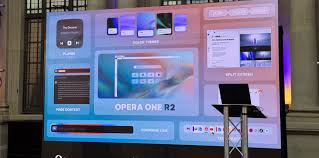Opera continues to be one of the main “challenger” browsers, giving tough competition to the world’s leading browser Google Chrome. Opera has a few versions of its browser and is launching a major upgrade to one of its alternatives: Opera One R2.
Opera is rolling out a huge upgrade to its new One R2 browser
Opera’s upgraded One R2 browser builds on its streamlined One browser, which was a major launch in 2023 and now has over 300 million users in its browser ecosystem. Opera One introduced Tab Islands, which are designed to help keep your workflow together by grouping similar tabs and topics.
Now, Opera’s One R2 browser is turning its focus to the evolution of multimedia, AI, and of course Tab Islands, which it is calling its “usability evolution.”
The Best New Features of Opera One R2
Opera has added a number of features to its new browser.
Dynamic themes
This is a great idea that makes changing your browser’s color scheme incredibly simple. Feeling the vibe? Change it to something bright and bouncy. Want to focus? Replace it with some darker, moody blues. Opera One R2 isn’t the first browser to use colorful themes, but its implementation is streamlined and doesn’t require you to download any extensions or add-ons to make it work.
At launch, there are three options, but Opera will add more. The dynamic themes come with specific audio and keyboard sounds, which is a nice touch. During the dynamic theme demo, Opera showed that each theme can be customized using a “joystick” that moves the theme through different emphasis. So, in the Polar Winds theme, I could make the visuals more pastel or more saturated. What’s more—and this is really cool—is that these themes are dynamic and generated on the go.
Split Screen Tabs
You can now drag your tabs wherever you want and create a quick split view between the information on the page. This creates a more integrated browser experience and will definitely be useful when you’re working and researching a lot of different information at once. It’s similar to how you split your screen with two browser windows, but now, it works across the browser.
Tab Trace
One of the most interesting upgrades to the Opera browser’s tab management is Tab Trace, a small upgrade that helps highlight the tabs you’ve used that day. If you’re like me, you probably keep a lot of tabs open at a time. While getting better at tab management would be a more practical option, Tab Trace helps when you come back to your machine the next day and pick up where you left off, helping to identify bits you’ve recently looked at and those you’ve left unchecked for a while.
Page Context
Opera’s integrated Area AI has also received a slight boost. Page context search gives you the power to find relevant information on a web page without leaving the thing you’re looking at. Right now, other AI chatbots have this power, but you have to open the chatbot, post a page, and wait for a response. Aria AI Page Context brings that power directly to the web page, summarizing information and helping you identify the specific bits of data that are important to you.
Modular media player
Now, this is a feature I really like. For a very long time, music players have been limited to a specific web page. Sure, pop-out extensions exist, but Opera’s modular media player lets you bring music to any web page.
I also like that you can turn the player into a modular part of the browser, putting it in your browser like a regular tab. It’s similar to Chrome’s integrated media controls, but being able to move it around is very useful. What I also like about it is that you can play different media, and when you close it, your music will start playing again, so no one media source interrupts the other.
Content Picks
Interestingly, Opera also has its own take on features like Google Discover, introducing human-curated content picks. I’m a bit skeptical about how this will work in the long run, as relevant content needs to be unique and specific to our algorithmically generated feed, but it’s another reason to consider switching to Opera.
